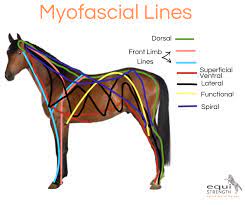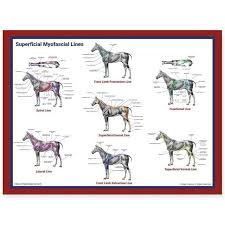Understanding Horse Fascia: What Every Owner Should Know
- Loz
- Aug 21
- 5 min read
Updated: Sep 22

A Practical Guide to Fascia Health for Your Horse
When it comes to equine anatomy, fascia is one of the unsung heroes supporting your horse’s movement, strength, and overall wellbeing. Understanding fascia and its health can help you become a more attentive and proactive horse owner, whether you’re caring for a retired paddock mate or an active competitor.
What is Fascia?
Fascia is a type of connective tissue that forms a web-like network throughout the horse’s body. Scientifically, fascia is made up of collagen fibres, water, and specialised cells, creating sheets and bands that wrap around muscles, bones, organs, and nerves. Its main job is to provide structure, support, and allow for smooth gliding of tissues during movement. In horses, fascia is essential for efficient locomotion, distributing forces evenly, and helping maintain posture and balance.
Healthy Fascia Function
In a healthy horse, fascia is supple, elastic, and well-hydrated. This allows muscles to contract and relax smoothly, joints to move freely, and the body to absorb shocks and stresses during activities like trotting, jumping, or simply rolling in the paddock. Healthy fascia helps prevent strain injuries, supports proper circulation, and even plays a role in nerve signalling. If your horse’s fascia is functioning well, you’ll notice fluid, coordinated movement and a relaxed posture.
Unhealthy Fascia: Compensatory Changes and Dysfunction
When fascia is compromised—whether due to injury, overuse, dehydration, or chronic tension—it can become thickened, sticky, or tight. This unhealthy fascia restricts movement and causes discomfort, sometimes leading to compensatory changes as the horse shifts weight or movement to avoid pain. Over time, this can result in lameness, muscle imbalances, or even behavioural changes. Unhealthy fascia can also limit blood flow and impede nerve function, making recovery from injuries slower and more complicated.
Equine Myofascial Lines

Understanding Myofascial Lines
Equine myofascial lines refer to the interconnected networks of muscles and fascia in horses that influence movement and overall body function. These lines are pathways through which tension and force are transmitted, affecting how horses perform and respond to training, injury, or stress.
Connection to Fascia
Fascia is a connective tissue that surrounds muscles, organs, and other structures in the body. It plays a crucial role in maintaining structural integrity and facilitating movement. In horses, fascia connects various muscle groups, creating a system of support and coordination. The myofascial lines are essentially the pathways formed by these fascial connections, allowing for efficient energy transfer and movement.
Understanding the Myofascial Lines
The myofascial lines in horses can be categorised into several key pathways, each serving a distinct function:
Superficial Front Line: Connects the front limbs and extends through the neck, influencing the horse's ability to lift and extend its forelimbs.
Superficial Back Line: Runs along the top of the horse, connecting the hindquarters to the head, impacting posture and balance.
Lateral Line: Runs along the sides of the horse, facilitating lateral movement and coordination between the fore and hind limbs.
Deep Front Line: Connects the deep muscles and fascia of the forelimbs to the core, crucial for stability and strength.
Deep Back Line: Involves the deep muscles along the spine, affecting overall posture and spinal alignment.
Root Causes of Myofascial Issues
Understanding the root causes of myofascial issues is essential for maintaining equine health and performance. Factors that can contribute to dysfunction include:
Improper Training: Poor riding techniques or training methods can lead to imbalances and strain on specific myofascial lines.
Injury: Trauma or repetitive strain injuries can disrupt the normal functioning of the myofascial system.
Posture: Poor posture can lead to uneven tension in the fascia, affecting movement efficiency.
Nutrition: Inadequate nutrition can impact muscle health and recovery, leading to myofascial dysfunction.
Stress: Psychological stress can manifest physically, causing tension in the fascia and muscles.
Visual Signs of Fascia Issues
Horse owners can often spot fascia problems by looking for subtle visual cues. One tell-tale sign is the presence of myofascial lines—visible lines or ridges along the ribcage, shoulders, or hindquarters. These lines are pathways where fascia and muscle interact and can become more pronounced if the fascia is tight or restricted. Other signs include uneven skin tension, dimpling, or patches where the coat looks odd. You may notice altered posture, restricted movement, or changes in muscle definition, especially after exercise or an injury.
Assessing Fascia Health: Tips for Owners
Observe Movement: Watch your horse walk, trot, and canter. Look for smooth, symmetrical movement and relaxed muscles.
Palpate the Skin: Gently run your hands along the horse’s sides, shoulders, and back. Healthy fascia feels soft and springy; unhealthy fascia may feel firm, ropey, or tender.
Check for Myofascial Lines: Look for visible lines or ridges, especially after exercise. Persistent or exaggerated lines might indicate fascia tension.
Monitor Recovery: After an injury or hard workout, observe how quickly your horse returns to normal movement and posture.
Feel Movement: Under saddle, feel for differences in your horse's body movements. For example, in walk, does your horse bend its ribcage equally left and right? Is there any brace or tension of movements?
Listen to Behaviour: Changes in temperament, resistance to grooming, or reluctance to move are clues that fascia may be involved.
Exercises to Support Healthy Fascia
Maintaining healthy fascia doesn’t require fancy equipment. Here are a few recommended activities:
Gentle Stretching: Encourage your horse to stretch its neck, back, and limbs. Carrot stretches and slow, controlled movements help lengthen fascia and improve flexibility.
In-Hand Walking: Regular, relaxed walks on varied surfaces stimulate fascia and improve hydration.
Massage and Grooming: Use soft brushes and gentle massage to promote circulation and loosen tight fascia. See my post on the best tools to use for this.
Dynamic Exercises: Groundwork, pole work, and hill walking encourage natural stretching and fascia engagement.
I particularly want to emphasize here that correct functional training is required here, and not just "aimlessly" walking your horse over poles and so on. I encourage you to reach out to an instructor who specialises in this or start deeply researching as there are many wonderful scientific studies on this (I'm thinking of Becks Nairn, Thirza Hendriks and Belinda Bolsenbroek here).
Hydration: Ensure your horse has access to fresh water, as well-hydrated tissue supports healthy fascia function.
Hot tip here: add at least (depending on your horse's weight, breed and workload - speak to your vet or equine nutritionist to verify how much if in doubt) 60g of salt to your horses daily feed to encourage drinking and balancing the sodium in their diet.
Conclusion
Fascia is a vital part of your horse’s anatomy, influencing movement, comfort, and overall health. By staying observant, learning to assess fascia health, and incorporating simple exercises into your routine, you’ll help your horse stay happy, comfortable, and ready for whatever adventures lie ahead. The study of equine myofascial lines is vital for understanding how horses move and function. By addressing the root causes of myofascial issues, equine practitioners can enhance performance, prevent injury, and promote overall well-being in horses.
Proactive fascia care is an investment in your horse’s long-term wellbeing—so why not start today?






Comments